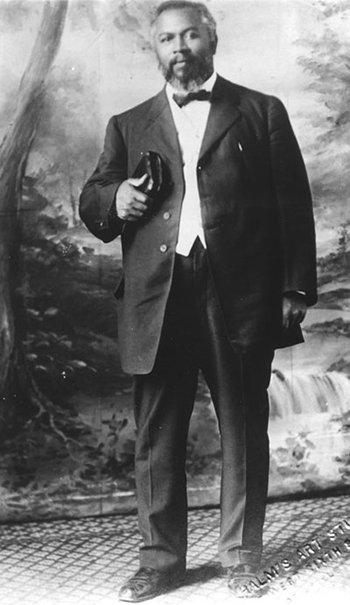1906 Los Angeles Revival
April 14 – Azusa Street, – William Seymour

William Seymour
Early in 1906, William J. Seymour, a black Holiness pastor, studied briefly at Charles Parham’s short-term Bible School in Houston, Texas. Segregation laws in that state prohibited blacks from joining the classes, so he sat in the hall and listened through the doorway.
Parham previously had conducted classes at a Bible College in Topeka, Kansas, where on January 1, 1901, a lady named Agnes Ozman spoke in tongues when Parham laid hands on her and prayed for her to be baptized in the Spirit. Soon Parham and half of the 34 students also spoke in tongues.
They taught that the gift of tongues was the initial evidence of baptism in the Holy Spirit. (In the early days they believed that these tongues were gifts of other languages to be used in missionary evangelism!) Those events have been seen as the beginning of Pentecostalism in America.
A small holiness church in Los Angeles invited William Seymour to preach with the possibility of becoming pastor of the church. His first sermon there, from Acts 2:4, emphasized being filled with the Spirit and speaking in tongues. When he arrived for his second service, he found himself locked out of the building!
Seymour then began cottage meetings in a home on Bonnie Brae Street, which still exists as a Pentecostal landmark. Many there, including Seymour, began speaking in tongues, and the numbers in attendance grew until the weight of the crowd broke the front veranda, so they had to move. They found an old, two-story, weatherboard stable and warehouse at 312 Azusa Street, which had previously been an African Episcopal Methodist church.
So Seymour, now leader of The Apostolic Faith Mission, began meetings there on Easter Saturday, April 14, 1906. About 100 attended, including both blacks and whites. The Spirit of God moved powerfully on that little mission. Many were baptized in the Spirit with speaking in tongues and prophecies. Four days later on Wednesday, April 18, the day of the San Francisco earthquake, the Los Angeles Times began carrying articles about the weird babble of tongues and wild scenes at Azusa Street.
Not only was the racial mixture unusual, but also the newspaper reports—usually critical of those noisy Pentecostal meetings—drew both Christians and unbelievers, poor and rich, to investigate. Soon crowds crammed into the building to investigate or mock. Hundreds were saved, baptized in the Spirit, and ignited for apostolic-style mission, which includes prayers for healing and outreach in evangelism and overseas mission.
Los Angeles Revival and Azusa Street
The exploding Pentecostal movement around the world usually traces its origins to Azusa Street, from where fire spread across the globe. For example, John G. Lake had visited the mission at Azusa Street. In 1908 he pioneered Pentecostal missions in South Africa where, after five years, he had established 500 black and 125 white congregations. Later he established healing rooms where thousands were healed through medicine and prayer at Spokane, Washington, which became known as the healthiest city in America at that time.
The Azusa Street revival touched the world, although it was not the first time a church experienced the gifts of the Spirit in revival. For example, Edward Irving, a Scottish Presbyterian pastor in London, began teaching on charismata in England and Scotland in 1825. By early 1830 parishioners near Glasgow experienced tongues and prophecies, and by 1831 these were common in his London church.
Expelled by the London Presbytery from his church in 1832 because of his views on Christology and because he gave permission for unordained men and women to give prophecies, he formed a church of 800, which became the Catholic Apostolic Church. His followers were nicknamed Irvingites. Irving died in 1834, and the church he founded gradually adopted liturgical elements but lasted barely another 40 years.
In contrast, on August 19, 1886, the Church of God (Cleveland), one of the oldest and largest Pentecostal bodies, was instituted as a small group called the Christian Union in Monroe County, Tennessee, to “sit together as the Church of God to transact business as the same.” In 1892 they formed a second fellowship 12 miles away in Cherokee County, in the mountains of North Carolina, where in 1896 at the Shearer Schoolhouse 130 believers experienced gifts of the Spirit including tongues and healings in their noisy meetings.
Their churches grew and multiplied in spite of violent persecution for a decade with churches and homes burned, and people flogged, shot at, and stoned. Their headquarters became established in Cleveland, Tennessee, where on January 11, 1907, they adopted the name, Church of God. From 1906, hearing of similar developments at Azusa Street, they taught the baptism of the Holy Spirit and gifts of the Spirit much more boldly.
So, to briefly summarize what we’ve already covered, the Great Awakening of the eighteenth century produced many revived churches and brought the Methodist Church into being. The evangelical revival produced movements, including the holiness churches of the nineteenth century. Those movements prepared the way for the surprising development of the Pentecostal churches and then the charismatic movement of the twentieth century.
© Geoff Waugh. Used by permission.
For further research:
Azusa Street Revival Wikepedia
Azusa Street Revival Edith Blumhofer



